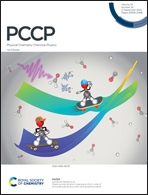Designing SnS/MoS2 van der Waals heterojunction for direct Z-scheme photocatalytic overall water-splitting by DFT investigation†
Abstract
Construction of direct Z-scheme photocatalytic heterojunctions with an internal electric field has been proposed as an outstanding method to achieve efficient utilization of solar energy for photocatalytic overall water-splitting. In this work, the properties of van der Waals (vdW) heterojunctions formed by group-IV mono-chalcogenides (MXs) (M = Ge, Sn; X = S, Se, Te) and MoS2 are systematically studied by first-principles calculations, including the vdW binding energy, the direction of an internal electric field and the electronic structure. The results predict that GeS/MoS2, GeSe/MoS2 and SnS/MoS2 vdW heterojunctions are potential direct Z-scheme water-splitting photocatalysts with appropriate band alignments, a wide light absorption range and low effective charge-carrier mass. Furthermore, the hydrogen evolution reaction (HER) and the oxygen evolution reaction (OER) activities of the heterojunctions as photocatalysts are predicted. The results indicate that SnS/MoS2 with the Sn vacancy has a low Gibbs free energy of the HER (0.06 eV), and MoS2 with the S edge can offer OER active sites. This study provides a theoretical basis for the further design and preparation of a new two-dimensional overall water-splitting photocatalyst, which is conducive to the development of efficient two-dimensional photocatalysts in the field of clean energy.



 Please wait while we load your content...
Please wait while we load your content...